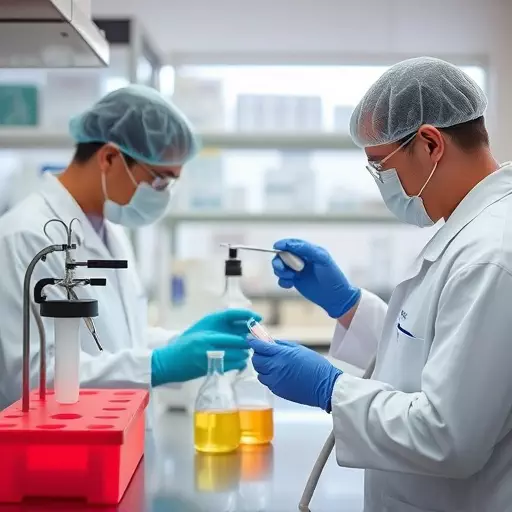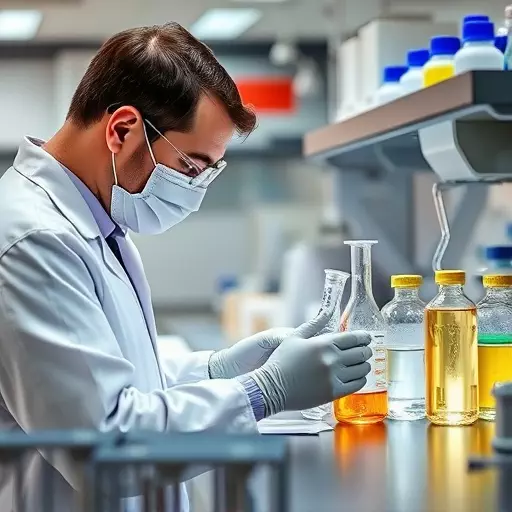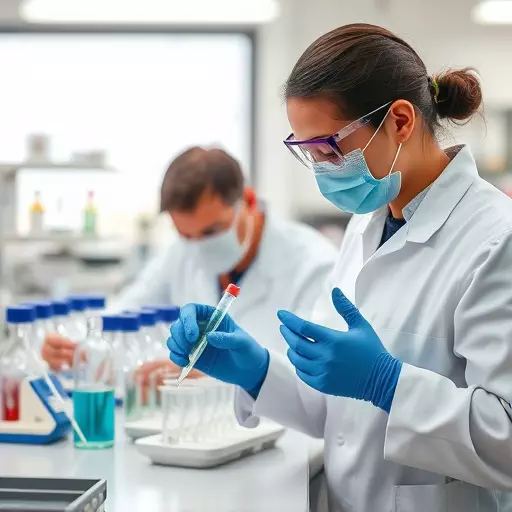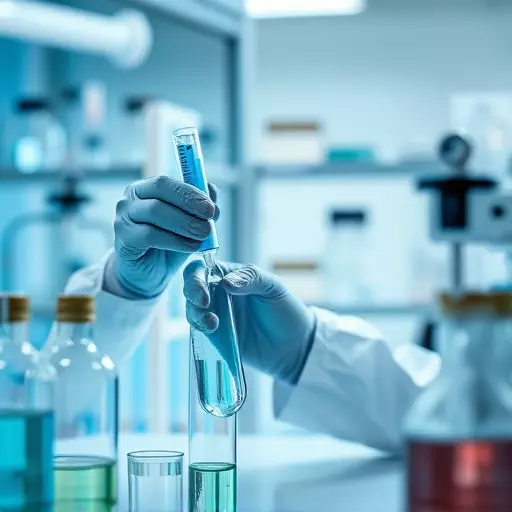In Columbus laboratories, titration is a key technique for chemical analysis, demanding precise concentration determination. Temperature control is paramount to prevent result skewing from even minor variations. Core steps in lab testing include meticulous reagent and sample preparation, uniform mixing, and consistent temperature regulation using devices like water baths. Accurate temperature monitoring ensures reliable results and prevents product degradation. In summary, robust temperature control mechanisms are vital for achieving consistent, reproducible outcomes in Columbus lab work, enhancing data integrity, and advancing scientific understanding through accurate chemical analysis.
“Dive into the fundamentals of titration—a cornerstone of chemical analysis in Columbus labs. This comprehensive guide explores the intricate process from start to finish. From understanding the foundational concept of titration to deciphering results using calculations and formulas, we uncover the core steps involved in laboratory testing. We emphasize the critical role of temperature control and the importance of accurate measurement with indicator solutions. Learn best practices for quality assurance, steering clear of common mistakes, and elevate your lab work in Columbus.”
- Understanding Titration: The Foundation of Chemical Analysis in Columbus Lab Work
- Core Steps Involved in Laboratory Testing Processes
- Temperature Control: A Crucial Aspect in Lab Environments
- Accurate Measurement: The Role of Indicator Solutions
- Calculations and Formulas for Interpreting Results
- Common Mistakes to Avoid During Titration Experiments
- Best Practices for Ensuring Quality Assurance in Columbus Laboratories
Understanding Titration: The Foundation of Chemical Analysis in Columbus Lab Work

In the heart of a Columbus lab, titration stands as one of the fundamental techniques in chemical analysis, underpinning countless scientific investigations and industrial applications. It involves a series of precise measurements where a known quantity of reagent is gradually added to a sample until a specific reaction reaches its endpoint. This controlled addition, often marked by a color change or other observable signal, allows for the determination of an unknown concentration with remarkable accuracy.
Mastering titration requires attention to detail and understanding the core steps in laboratory testing processes. Temperature control, in particular, plays a pivotal role in ensuring the reliability of results. Even minor fluctuations can alter chemical reactions, introducing errors into the analysis. Thus, maintaining consistent temperatures throughout the titration process is essential, highlighting the importance of temperature control in lab environments for accurate and reproducible outcomes.
Core Steps Involved in Laboratory Testing Processes

In any lab work in Columbus or beyond, understanding and meticulously following core steps in laboratory testing processes is paramount for accurate chemical analysis. The first step involves preparing reagents and samples, ensuring all materials are at the correct concentration and ready for use. This requires precise measurement and careful handling to avoid contamination. Next, a known quantity of analyte is combined with a measured volume of indicator or titrant solution in a flask or beaker. The mixture is then stirred or agitated to ensure uniform distribution.
Temperature control plays an indispensable role in these processes, as chemical reactions often have optimal temperature ranges. In lab environments, maintaining consistent temperatures ensures the reaction proceeds at the expected rate and to the desired completion. This step might involve using heating or cooling devices like water baths or ice baths, depending on the reaction requirements. Accurate temperature monitoring not only guarantees reliable results but also prevents unwanted side reactions or product degradation.
Temperature Control: A Crucial Aspect in Lab Environments

In the realm of lab work in Columbus and beyond, temperature control is one of the core steps in laboratory testing processes that cannot be overlooked. It plays a pivotal role in ensuring the accuracy and reliability of chemical analyses. Even slight variations in temperature can significantly alter chemical reactions and affect the outcome of experiments. Therefore, maintaining precise temperature control becomes essential for achieving consistent and reproducible results.
In lab environments, where precision is paramount, the importance of temperature control cannot be overstated. It involves meticulous monitoring and regulation to create an optimal condition for each experimental procedure. This is particularly crucial in chemical titration, a fundamental technique in analytical chemistry, as temperature can influence reaction rates, equilibrium points, and even the physical state of reagents. By implementing robust temperature control mechanisms, laboratories in Columbus can enhance data integrity, foster reliable research outcomes, and ultimately contribute to the advancement of scientific knowledge through accurate chemical analysis.
Accurate Measurement: The Role of Indicator Solutions

In the realm of chemical analysis, accurate measurement is paramount for reliable lab work in Columbus and beyond. One of the core steps in laboratory testing processes is titration, where the precise quantity of an unknown solution is determined by reacting it with a known reagent. The role of indicator solutions cannot be overstated; these specialized chemicals play a crucial part in achieving accurate measurements during titration. By changing color at a specific point—known as the endpoint—indicator solutions signal when the reaction has reached its completion, ensuring precise and consistent results.
Maintaining temperature control is another critical aspect within lab environments. In terms of titration, even minor fluctuations in temperature can significantly alter chemical reactions and, consequently, affect measurement accuracy. Therefore, laboratory technicians must ensure meticulous temperature control throughout the process, often employing water baths or other heating/cooling devices to maintain a consistent environment. This attention to detail, combined with the strategic use of indicator solutions, reinforces the importance of precise lab work in Columbus and contributes to the overall reliability of chemical analysis.
Calculations and Formulas for Interpreting Results

In the core steps of laboratory testing processes for chemical analysis, titration plays a pivotal role. Calculations and formulas are essential tools to interpret results accurately in lab work in Columbus or any scientific setting. One fundamental equation used in titration is the stoichiometric calculation, which relates the amount of reactants and products based on their mole ratios. This equation ensures that the amounts of substances are precisely measured and compared during the titration process.
The importance of temperature control cannot be overstated in lab environments. It directly impacts chemical reactions and, consequently, the accuracy of results. In many cases, especially for complex chemical analyses, maintaining a controlled temperature is a core step in laboratory testing processes. This ensures that reactions proceed at optimal rates and that byproducts or side reactions are minimized, leading to more reliable and reproducible data.
Common Mistakes to Avoid During Titration Experiments

In any lab work in Columbus or beyond, titration experiments require meticulous attention to detail to ensure accurate results. Common mistakes that can skew data include improper temperature control. Since chemical reactions are highly sensitive to temperature, maintaining a consistent and controlled environment is crucial for reliable laboratory testing processes. Using a water bath or other heating/cooling devices can help stabilize the solution during titration.
Another frequent error involves not adding the indicator dropwise while stirring. This can lead to inconsistent point-of-equivalence detection. Additionally, ignoring the cleaning and calibration of equipment before each experiment is a recipe for error. Always rinse and dry containers, and ensure your instruments are properly calibrated to avoid introducing contaminants or misreading results during core steps in laboratory testing processes.
Best Practices for Ensuring Quality Assurance in Columbus Laboratories

In Columbus laboratories, upholding quality assurance is paramount to ensure accurate and reliable chemical analysis. Best practices for achieving this involve a multi-faceted approach that integrates meticulous attention to detail with adherence to standardized protocols. Firstly, maintaining rigorous standards during lab work in Columbus is essential. This includes consistent calibration of equipment, precise documentation of procedures, and regular training sessions for personnel to ensure uniformity in core steps of laboratory testing processes.
Moreover, the importance of temperature control in lab environments cannot be overstated. Many chemical reactions are highly sensitive to temperature fluctuations, which can significantly impact results. Therefore, Columbus laboratories must invest in advanced temperature control systems and implement strict protocols to maintain optimal conditions throughout experiments. This ensures the integrity of data and promotes consistent quality outcomes in all lab work conducted.
